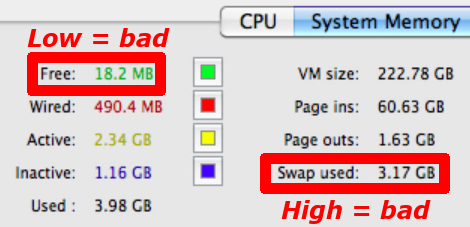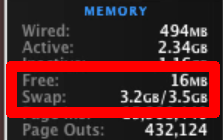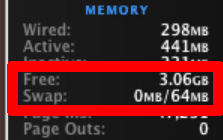Does your Mac run slowly, sometimes turning your cursor into that darn spinning beach ball? ![]() It may be because your running applications have used up all your memory. In the video below I show two tools you can use to check how much of your Mac’s memory is being used, and what numbers to look for.
It may be because your running applications have used up all your memory. In the video below I show two tools you can use to check how much of your Mac’s memory is being used, and what numbers to look for.
As a bonus you’ll also see how easy it is to download and install a new widget on your Dashboard.
Do you do any of these?
- Use your Mac for many days (or weeks?!) without restarting it
- Run many applications simultaneously
- Open dozens of browser tabs or windows, or many large documents
- Use a web-based email program like Gmail
If so, congratulations, you are getting your money’s worth! Heck, I do ALL of those. But the more of those you do, the more likely your Mac will start slowing down due to lack of memory. But keeping apprised of your Mac’s memory situation is easy. Watch this video to see how.
Monitoring your Mac’s memory
The Activity Monitor application that comes with Mac OS X (in the Utilities folder) is an adequate way of checking your memory usage but I prefer the Dashboard widget, iStat Pro (click this link to download). I usually check my iStat Pro readings a few times a day. It only takes a couple seconds if you know what to look for.
Whichever tool you use, the two most important measurements to check are your “free” memory and “swap used”. To see the swap number in iStat Pro, you must set its memory section to “Advanced”. Do this by clicking on the widget’s “i” button (in the upper left), clicking on the Sections tab, and changing the Memory setting to Advanced. If you notice your Mac slowing down and you see low “free” memory and high “swap used”, it’s time to start freeing up some memory.

Activity Monitor showing low free memory and high swap used

iStat Pro showing low free memory and high swap used
Freeing up memory
The most thorough way to free up your Mac’s memory is to perform a restart. But if you don’t want to take the time for a full restart, here are some quicker things you can do to free up some memory and possibly speed up your Mac.
- Close unneeded browser tabs or windows, especially the ones with long histories
- Close web-based email tabs (like Gmail) and start a new session in a newly opened tab
- Quit and restart applications that have been heavily used (lots of tabs, lots of documents, etc.)
- Log out of your computer user name and log back in
After one or more of those steps, you’ll get closer to the memory conditions you had when you first turned on your computer.

iStat Pro showing high free memory and low swap, after a full restart
So take a quick look at your Mac’s memory usage a few times a day and you’ll soon learn which of your activities tends to use up memory and at what memory levels your Mac starts to slow down. Then, the next time your Mac slows down you’ll be able to diagnose if it’s caused by memory issues. If not, then a bad Internet connection or slow website could be slowing your Mac. But if it is, at least you have some control over your memory usage and now you have some actions you can take to help solve the problem.
The Geek Box
Warning: The following is a week of my graduate-level operating systems course condensed into one paragraph!
When too many applications run for too long, they can use up all the available memory in your computer. After that, when one of those applications needs more memory (for instance, maybe you opened yet another tab in Safari) and there is no more unused memory, the system has to temporarily move (or “swap out”) the least recently used (but still running) application out of memory to a special location on your disk. Most of the time, using this “swap space” magically lets you do more on your Mac than if you were restricted to the computer’s physical memory.
But as the amount of swap space used grows, your Mac’s speed can degrade. In extreme cases, your Mac can get into a vicious cycle of swapping out application A to make room for application B, then swapping out B to make room for A, and so on. This is called “thrashing” and is often the cause of the dreaded spinning beach ball cursor freezing your Mac for a long time. That’s when shutting down some applications or (even better) restarting your Mac is the next order of business.
Two readers (Mom and a builder guy from NH) both asked how to see the swap numbers in iStat Pro. I guess I breezed through the iStat Pro settings too quickly and forgot to make clear the importance of one of those settings. I’ve added this to the article above:
To see the swap number in iStat Pro, you must set its memory section to “Advanced”. Do this by clicking on the widget’s “i” button (in the upper left), clicking on the Sections tab, and changing the Memory setting to Advanced.
There is an excellent manual for iStat Pro which you can see by clicking the widget’s ? button, or by going here: https://islayer.com/help/istatpro-manual/
Steve,
I’m that builder guy from NH. This was a GREAT article. I always knew the spinning beach ball indicated that the computer had gotten lazy, but didn’t know why and how to monitor it walking towards the Great Computer Hammock.
Thanks for this great article and video. I would have watched the video, but I’m rooming with this guy on this road trip I’m on. He likes to stay up till about 3 am watching TV. I hit the rack early and get up early. I couldn’t watch the video for fear of waking up the grumpy bear.
Hey Tim, sorry to hear your road trip buddy is grumpy. At least he doesn’t snore like a chain saw.
Anyway, you bring up a good point. Although I try to include all the important details in the text of these articles, I do consider the video as a critical piece of the article. So I suggest getting some headphones so you can watch without waking the grumpy bear. Or, heck, although you’d miss my witty banter with myself, you could watch the video with no sound so you could at least follow along with all the steps. That reminds me of my new article and video on how to follow along with these videos. https://www.machelpformom.com/227-follow-along-with-video-tutorials
Now I know why Tim hasn’t answered the question I posed on HIS website about saw blades. He probably is not getting enough sleep because of snoring. Cheers. jm
Hi Steve,
You’re a gem. Another timely article! Can you believe it – I was hit by that spinning beachball just before I watched your video and had no idea what caused it. I waited and waited and in the end, thought why don’t I try shutting down and restarting my Mac. It seemed to work. And now I know why. TQ again.
By the way, I’m that gal who had trouble loading my profile pic up to ArticlesBase. 🙂
Thank you so much for such a clearly written article for a new-to-mac person. It is much appreciated.
Now if you could only write more articles like this on ‘how to COMPLETELY uninstall applications on mac’. 😉 Hint!
Thanks Rachel! I’m working on the uninstall question. I need to do some research first.
I am receiving your memory is full error anytime I attempt to open an attachment or download a file. I have restarted my computer and still receive this issue. I have looked at the processes running and it appears I have available memory. My hard drive is only 60% full so I dont believe its a combination of a full hard drive and too many processes running in my memory. Help!!!!!!
Thanks for the video! That was really helpful!